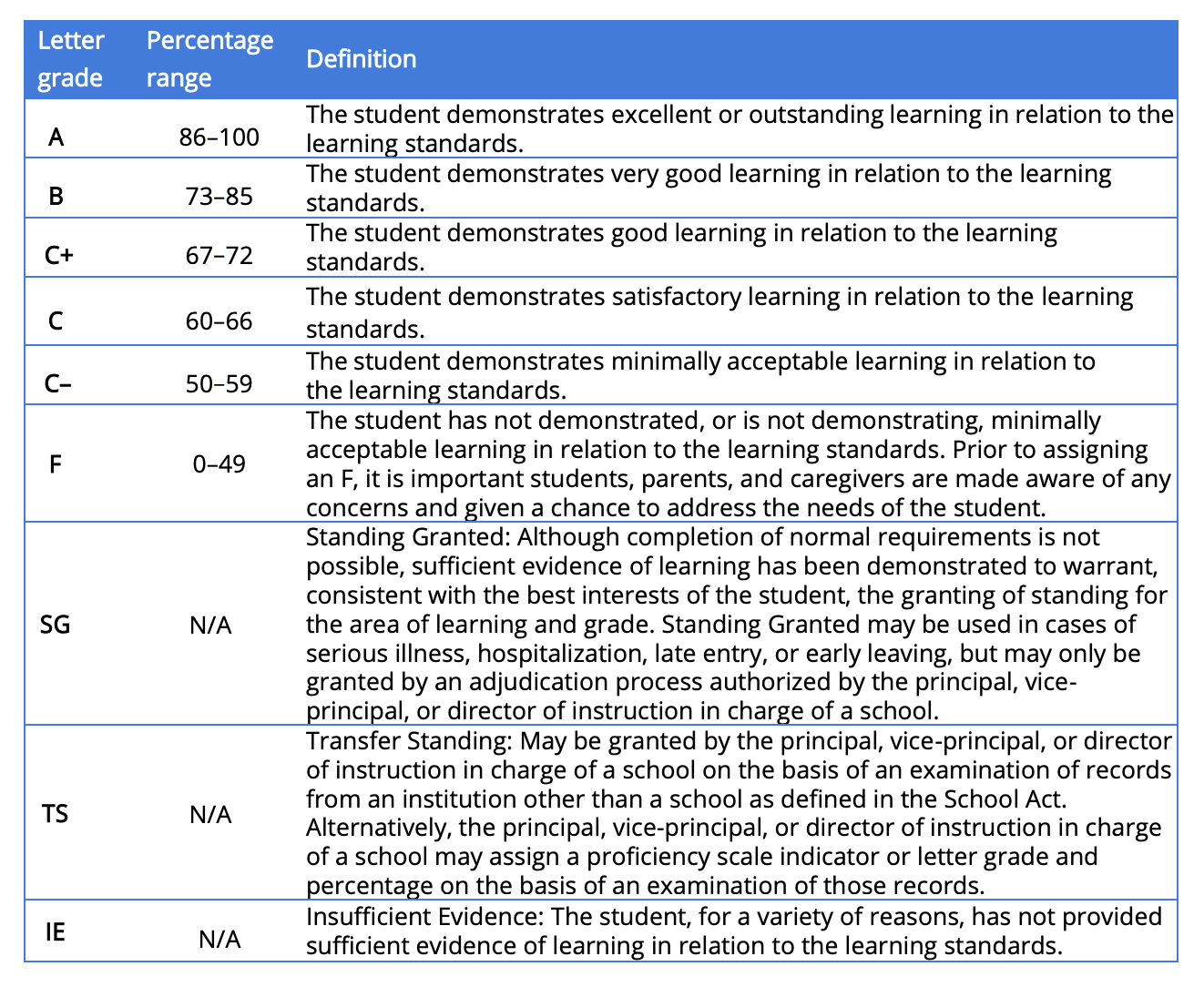Assignment Grading Policy
Flex Academy takes a cumulative approach to learning. Learning demonstrated close to the communication of student learning is the most reflective of student proficiency and is used as the strongest evidence of learning.
The Four-Point Provincial Proficiency Scale
This four-point scale is used to communicate student learning in all areas of learning in Grades K-9, and it is a requirement for student reporting in Grades K-9. The four points on the scale are Emerging, Developing, Proficient, and Extending.
| Grade | Definition |
|---|---|
| Extending | The student demonstrates a sophisticated understanding of the concepts and competencies relevant to expected learning. |
| Proficient | The student demonstrates a complete understanding of the concepts and competencies relevant to expected learning. |
| Developing | The student demonstrates a partial understanding of the concepts and competencies relevant to expected learning. |
| Emerging | The student demonstrates an initial understanding of the concepts and competencies relevant to expected learning. |
Students come into learning situations with their own experiences and background knowledge. Students do not necessarily begin at Emerging or Developing at the beginning of each school year. Similarly, students do not always reach Proficient at the end of the school year and obtaining Proficient is not the end of learning!
If a student enters a learning experience with Proficient understanding or achieves Proficient during the school year, the aim becomes to dig deeper and reach toward Extending their understanding.
Assessment provides timely feedback to students for continued learning, improvement and growth.
Letter Grades and Percentages
Letter grades and percentages are used in Grades 10-12 to indicate a student’s learning in relation to the learning standards. The Provincial Letter Grades Order sets out the process for letter grade symbols and corresponding percentages and definitionsdefinitions.
| Letter | % |
Definition |
|---|---|---|
| A | 86-100 | The student demonstrates excellent or outstanding performance in relation to learning outcomes for the |
| B | 73-85 | The student demonstrates very good performance in relation to learning outcomes for the course. |
| C+ | 67-72 | The student demonstrates good performance in relation to learning outcomes for the course. |
| C | 60-66 | The student demonstrates satisfactory performance in relation to learning outcomes for the course. |
| C- | 50-59 | The student demonstrates minimally acceptable performance in relation to learning outcomes for the course. |
| F | 0-49 | The student is not demonstrating minimally acceptable learning in relation to the learning outcomes for the course. The letter grade “F” may only be assigned if an “IE” (Insufficient Evidence of Learning) letter grade has previously been assigned for that course. |
| SG | N/A | Standing Granted: Although completion of normal requirements is not possible, sufficient evidence of learning has been demonstrated to warrant, consistent with the best interests of the student, the granting of standing for the area of learning and grade. Standing Granted may be used in cases of serious illness, hospitalization, late entry, or early leaving, but may only be granted by an adjudication process authorized by the principal, vice principal, or director of instruction in charge of a school. |
| TS | N/A | Transfer Standing: Although completion of normal requirements is not possible, a sufficient level of performance has been attained to warrant, consistent with the best interests of the student, the granting of standing for the course or subject and grade. Standing Granted may be used in cases of serious illness, hospitalization, late entry or early leaving but may only be granted by an adjudication process authorized by the principal, vice principal or director of instruction in charge of the school. |
| IE | N/A | Insufficient Evidence: The student has not provided sufficient evidence of learning in relation to the learning outcomes for the course. |
Assignment of an "Insufficient Evidence" Letter Grade
- An
"IE" ((Insufficient Evidence)IE may be assigned at any time during the school year and is not restricted to term and final reports. - Where an
"IE" ((Insufficient Evidence)IE is assigned, the student and the parent of the student must be informed and have an opportunity to consult with the teacher on the plan of action specified in subsection (3). - Where an
"IE" ((Insufficient Evidence)IE is assigned, teachers must be prepared to identify what the problem is and specify a plan of action that is intended to help students achieve the curricular competencies. - An
"IE" ((Insufficient Evidence)IE may be communicated in a variety ofwaysways, including a written plan, verbally by telephone, or in a direct meeting involving teacher, parents and students. - Where an
"IE" ((Insufficient Evidence)IE is assigned, the"IE"IE letter grade must be converted to another letter grade:- when letter grades are recorded on the permanent student record card,
- before submission to the ministry for inclusion on that student's transcript of grades, and
- before a student's records are transferred to another school unless there is an agreement between the principals of the two schools to defer the conversion of the
"IE"IE letter grade.[en. M394/94; am. M330/97; am. M33/04]
Insufficient Evidence (IE) is not a final grade. This temporary grade aims to get students, parents, and caregivers working with teachers to have willing students demonstrate further evidence of learning to have the student’s mark eventually translated into a proficiency scale indicator or letter grade and percentage.
Successful Completion of Courses in Grades 10, 11 or 10-12
The successful completion ofCompleting a course numberedin 10,Grades 11 or 10-12 requires a minimum of a C- grade.[am M321/04 ; am M199/11]


